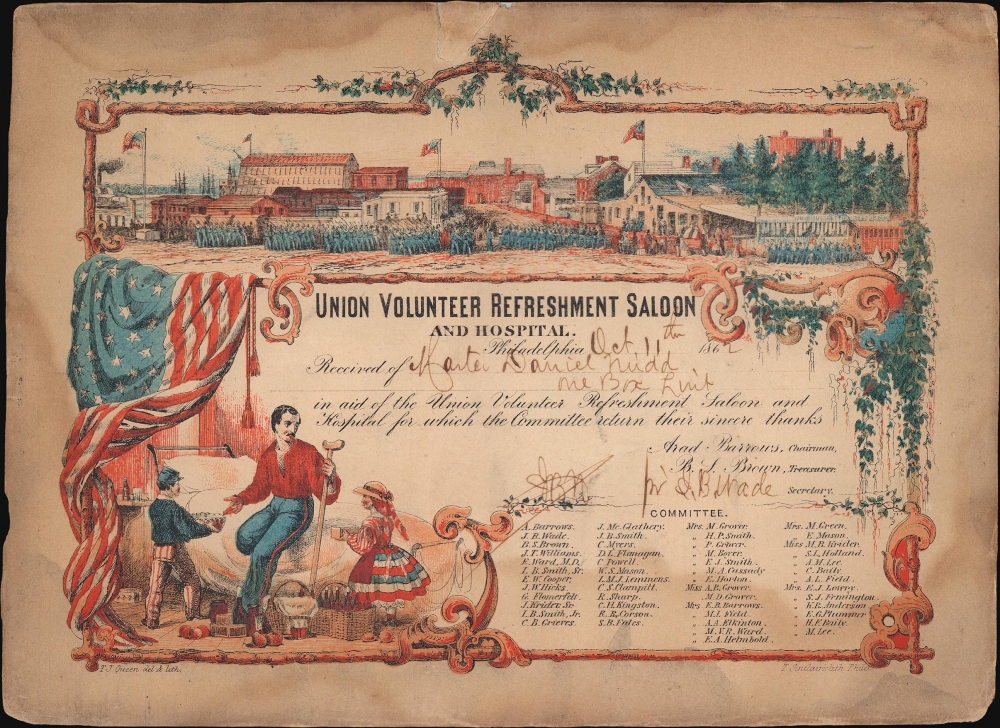1861 J. F. Queen Union Volunteer Refreshment Saloon Donation Certificate
UnionSaloonDonation-queen-1861
Title
1861 (undated) 5.25 x 7.25 in (13.335 x 18.415 cm)
Description
A Closer Look
A view of Philadelphia illustrating soldiers marching past the Saloon occupies the top. Individual soldiers and muskets are easily discernable. An American flag is draped over the left side and hangs from the border, partially framing a vignette of children helping an amputee. Text occupies most of the certificate, with the present example, dated October 11, 1862, made out to Nate Daniel Nudd in recognition of a donation of one box of bandages. It is signed by B. Wade.The Union Volunteer Refreshment Saloon and Hospital of Philadelphia
Opened on May 27, 1861, the Union Volunteer Refreshment Saloon began at the corner of Washington Avenue and Swanson Street as the project of Barzilai Brown, a Philadelphia grocer. The Saloon offered refreshments, lodging, stationery, and stamps to soldiers transiting between the Navy Yard and the railway station. A hospital was added in September 1861 to accommodate the sick and wounded. Between its opening and its closing on December 1, 1865, the Saloon helped over 800,000 Union soldiers and served over 1,025,000 meals. Although the Saloon initially closed on August 28, 1865, demand from soldiers returning from the South encouraged it to reopen.Publication History and Census
This certificate was created and engraved by James Fuller Queen and printed by Thomas Sinclair c. 1861. We note three similar surviving examples: two at the Library of Congress (one colored and filled out; the other blank and uncolored) and a third at the Library Company of Philadelphia. We have not found records of similar certificates entering the private market.CartographerS
James Fuller Queen (1820/21 - January 15, 1886) was a Philadelphia-based lithographer, chromolithographer, and artist, and is remembered for his composition and attention to detail. Born in Philadelphia in 1820 or 1821, Queen's lithography career began after he became an apprentice to George Lehman and P S. Duval on November 24, 1835. Queen spent the next 5 years as Duval's apprentice and remained associated with him for the rest of his career. Queen also worked with Wagner and McGuigan, Duval's major business rival, during the mid-1840s, but most of his output was published by Duval. In 1861, Queen became the superintendent of the drawing department at the Duval firm. Queen continued working for Duval during the American Civil War (1861 - 1865) despite enlisting in the Pennsylvania Militia during the summers of 1862 and 1863, and Queen produced some of his best work during the Civil War years. He identified himself as a chromolithographer by the 1870s and worked into the early 1880s. He died of multiple sclerosis on January 15, 1886. Queen married Sarah Harvey in 1843 with whom he had three daughters. More by this mapmaker...
Thomas S. Sinclair (c. 1805 - 1881) was an American lithographer. Born in the Orkney Islands, Scotland, Sinclair studied lithography in Edinburgh and other European cities before moving to the United States sometime before 1833. He was established in Philadelphia by 1833, when he drew a dancing scene for the firm of Kennedy and Lucas, which went out of business that same year. In 1838, Sinclair acquired the press of John Collins and opened his own lithography firm. He was among the first lithographers in Philadelphia to experiment with color lithography, beginning in 1843. By 1848, his skills ad advanced to such a degree that he won a silver medal for color lithography at the Franklin Institute's exhibition. Sinclair's brother, William B. Sinclair, joined the firm in 1854, and from that year until 1859 the establishment was known as Thomas Sinclair and Company. His son joined the company at one point also, and then the firm's name changed to Thomas Sinclair and Son. Sinclair died in Philadelphia in 1881. Learn More...

